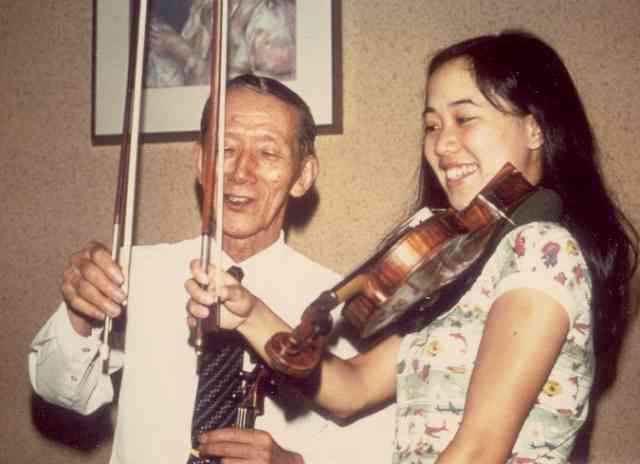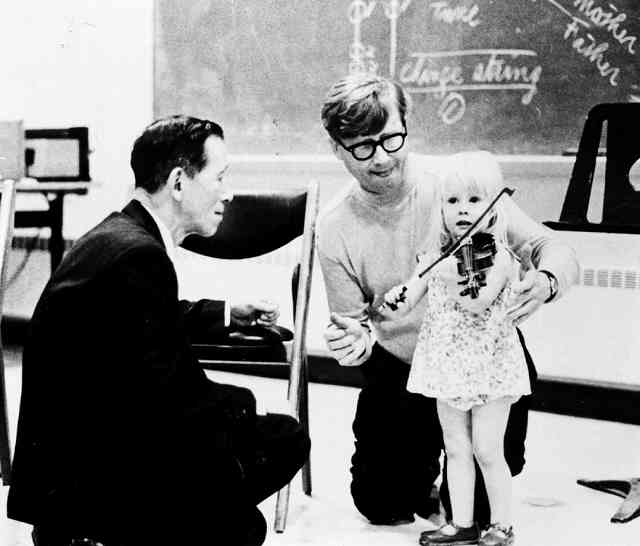Instilling the Desire to Learn

Cathy Lee and Dr. Suzuki
Excerpted from Nurtured by Love, pp 95-96.
We encourage them to think of violin training as fun
We begin by training the parent rather than the child. Although we accept infants, at first we do not have them play the violin. First we teach the mother to play one piece so that she will be a good teacher at home. As for the child, we first have him simply listen at home to a record of the piece he will be learning. Children are really educated in the home, so in order that the child will have good posture and practice properly at home, it is necessary for the parent to have firsthand experience. The correct education of the child depends on this. Until the parent can play one piece, the child does not play at all. This principle is very important indeed, because although the parent may want him to do so, a three- or four-year-old child has no desire to learn the violin. The idea is to get the child to say, “I want to play too;” so the first piece is played every day on the gramophone, and in the classroom he just watches the other children (and his mother) having their lessons. The proper environment is created for the child. The child will naturally before long take the violin away from his mother, thinking, “I want to play too.” He knows the tune already. The other children are having fun; he wants to join in the fun. We have caused him to acquire this desire.
We encourage them to “play” with the violin

Dr. Shinichi Suzuki and Alfred Garson and with a young violin student
This situation having been created, lessons are led up to in the following order. First the parent asks,
“Would you like to play the violin too?”
The answer is yes!
“You will practice hard?”
“Yes.”
“All right; let’s ask the teacher if you can join in next time.”
This always succeeds. What a thrill the first private lesson always is! “I did it too,” the child boasts. “Now I can play with the other children.” Parents who understand children make fine teachers. In the classroom there are private lessons and group lessons. Parents who do not understand children think they are paying for the private lessons and that the group lessons are just recreation periods. So although they make sure that their children attend the private lessons, they often fail to bring them to the group lessons. But the fact is that what the children enjoy most is the group playing. They play with children who are more advanced than they are; the influence is enormous and is marvelous for their training. This is the real talent education.
Although the following excerpt is from a brochure by Shinichi Suzuki titled “How to Teach Suzuki Piano,” it speaks to every parent and teacher, regardless of what instrument they may deal with, about the principles of the Suzuki method which form the foundation for all instruction. He expresses his own personal philosophy which then guides parents and teachers as they introduce the specific technical musical concepts applying to various instruments.
The Use of Musical Scores
Because I often receive questions about teaching children to read music, I would like to explain my thinking and approach on this subject.
The ability to read music is one important aspect of musical ability. However, the printed score must never be confused with music itself; it is nothing but a symbol of it. I believe that true music reading means discovering the composer’s musical idea and expressing it aloud in a beautiful manner. For example, everyone recognizes a speaker of the Osaka dialect because he uses a special lilt, nuance, and accent characteristic of that region. When a person from Tokyo reads a transcribed version of Osaka dialect, this is not the same as real Osaka dialect because it lacks that special lilt.
Nobody teaches a baby to talk by starting with printed letters and words. The natural order is to teach letters and reading after a child learns to talk. In the same manner, in teaching preschool children, we do not use printed music, but rather have them learn new songs from listening to the record and showing them how to play. Mothers should be taught to read music, however, because they need this skill to help their children practice.
Music is an Aural Art
Because music is something that we appreciate aurally, it is important to teach it as an aural medium. When using one’s eyes, the ears are less attentive. If you play in the dark, you become more aware of different musical inflections and nuances. The habit of practicing while reading music lowers students’ aural sensitivity and they tend to not listen to their own playing, in the manner of a typist.
Please teach mothers to read music so that they can help their children learn new pieces, but wait to teach the students until an appropriate age and time. Until that time, I think that it’s more important to develop the ear so that children listen to and judge their own sound, use an expressive forte and piano, and have a fine sense of tempo and rhythm. The goal of instruction is to develop students who depend upon the sound of a piece rather than upon a musical score.
Later, after we have taught children to play notes from looking at a musical score, we must teach them the habit that once they have learned a piece from a score, they should continue to study and perform the piece from memory. In my own teaching, I only assist students with that part of the piece which they can play from memory. If one uses this method until it becomes a habit for the students, it develops their memory and gives them the ability to play without a musical score.
The Ability to Memorize Quickly
In my teaching experience, some very diligent and highly developed students have been able to learn and memorize in one week long and difficult works such as the first movement of the Sibelius violin concerto, the entire Tchaikovsky concerto, or the first movement of the Brahms violin concerto. Most advanced students are able to do this. This type of ability is much less likely to be developed in a student who always relies on a musical score. It is very important to remember the goal of developing in students the ability to quickly memorize and play pieces with confidence once they have learned them from a musical score. I do not believe that reading music is unimportant, but as in the relationship between letters and sentences, I believe that it is also necessary to develop the abilities which underlie reading music.
This means that the teacher should first explain musical notation to the mother and teach her how to read the score. The child should listen often to the record, and if there are difficult passages, the mother gives assistance.
In this way, the child will come to play musically, listening to his or her own sound and musical expression. If such powers of discrimination are developed, when children do use a musical score, they will be able to do so to produce real music.
It is also probably necessary to practice sight reading. However, this comes after the child’s basic ability has been developed, as mentioned above. If students have fine musical understanding and sensitivity they will be able to catch the real music from the musical score, which is after all the true meaning of reading music.
